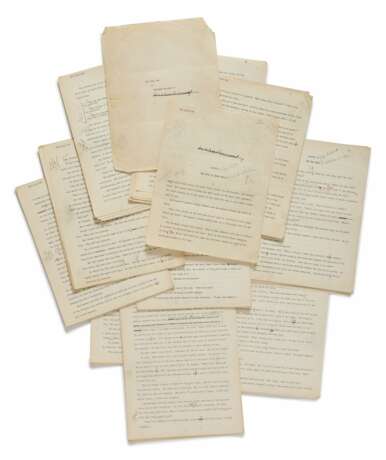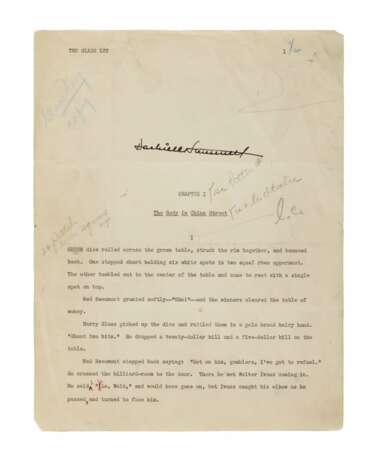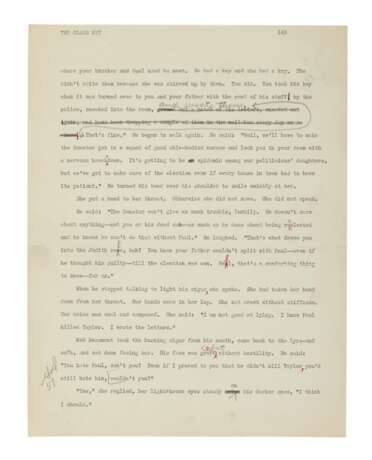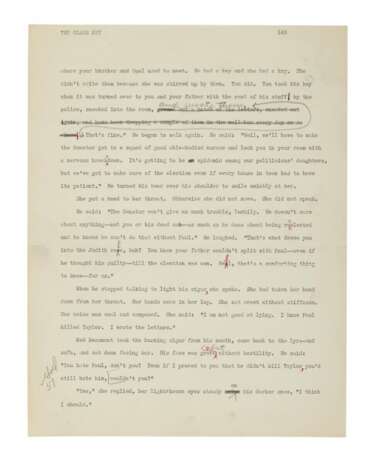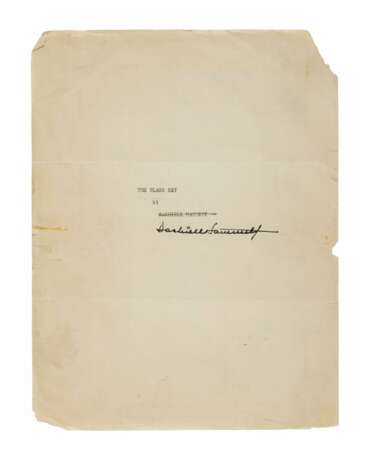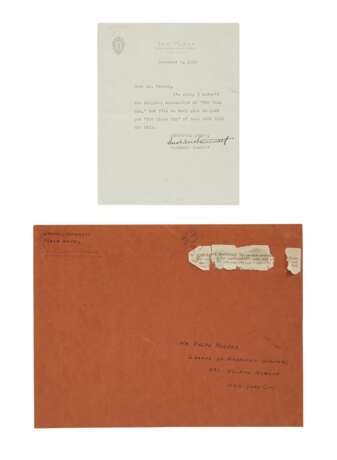ID 796077
Лот 1012 | Hammett, Dashiell | Typescript of this classic detective novel, with extensive annotations by the master of the genre
Оценочная стоимость
$ 100 000 – 150 000
The Glass Key, complete typescript with autograph corrections. [Np, nd, but ca. 1929-1930]
216 leaves (280 x 215 mm), typescript signed ("Dashiell Hammett") twice, once on the title-page and again at the head of the first page, 214 numbered pages (numbered 1-40 and 42-215, but complete), smaller leaf affixed to page 42 with a nail and handwritten in blue ink, "We had no page 41," running header on pp. 7-8 reads "The Shattered Key" with "Shattered" crossed out and corrected in Hammett's hand to "Glass," numerous other autograph annotations and corrections throughout; hole-punch to the upper right corner of most pages, causing tears and chips to the corners, some of which repaired, not affecting text save the cost of one letter on p. 114, soiling due to printer's ink throughout, moderate wear overall. [With:] Typed letter signed ("Dashiell Hammett"), New York, 4 December 1938, to Mr. [Ralph] Roeder. 4to, 1 p. (188 x 146) on The Plaza hotel stationary; stray smudges from erased pencil and where a paperclip had been affixed, old fold. [And with:] The upper cover of a folder (280 x 215 mm), presumably used to encase the typescript for delivery, addressed "Mr. Ralph Roeder | League of American Writers | 381 Fourth Avenue | New York City" and with the return address "Dashiell Hammett | Plaza Hotel"; old dealer's description adhered to folder and worn. Housed in a quarter green morocco clamshell box, with brown leather inlay of a shattered key, mimicking the design of the first edition.
The complete typescript of Hammett's favorite of his own novels, with extensive autograph corrections.
A truly remarkable archive, not only showcasing a still in-progress version of this essential detective novel, but also illuminating Hammett's editorial process. The typescript was mailed by Hammett to the American leftist writer Ralph Roeder, when he was still living in New York prior to his self-imposed exile in Mexico City. Roeder had, evidently, requested from Hammett the typescript of then his latest novel, The Thin Man, as Hammett's letter in response, included here, reads: "Dear Mr. Roeder, I'm sorry I haven't the original manuscript of 'The Thin Man,' but I'll be very glad to give you 'The Glass Key' if that will fill the bill. Sincerely yours, ('Dashiell Hammett') Dashiell Hammett."
The Glass Key followed the publication of The Maltese Falcon, and this period of his work is widely considered to be the high point of his career, when he was writing at the peak of his powers. Hammett, himself, felt The Glass Key was his greatest work—not only because it represented his most serious attempt at a novel irrespective of the conventions of the detective genre, but also because he felt the clues were well placed and that the narrative was the most tightly structured of his works thus far.
The novel represents the apex of Hammett's literary style—the language is tightly restrained, maintaining an artifice of hyper-realist objectivity through which its characters' minds remain unknowable to the reader. To maintain both mystery and, perhaps, what Hammett felt was fidelity to life, the inner subjectivity of his characters could not be legible, neither to each other nor the reader. Indeed the typescript reveals how Hammett achieved this style, illuminating the ways in which he winnowed away at both subjectivity and speculation, leaving only the bare particulars of characters' actions for the reader to interpret. In a striking example, the final sentence of the typescript reads, "Janet Henry looked at Ned Beaumont. He stared fixedly at the door as if to avoid her eyes." Yet the final printed version of the text omits "as if to avoid her eyes," letting the sentence end merely at the description of Beaumont's gaze.
After its original serialization in Black Mask, March to June, 1930, The Glass Key was first issued in book form in London in January 1931; the first American edition was published in April of that year. "In Red Harvest the Op arrives to clean up the Western town. The Dain Curse is a fairy tale of an enchanted damsel in distress, and The Maltese Falcon is a treasure hunt. Now [in his fourth novel, The Glass Key] his subject was loyalty among men (a theme occurring in some of the earlier tales as well), but where the Op and Sam Spade were confronted with tests of loyalty in conventional situations and had to choose between doing their job and succumbing to the temptations of making money or seducing beautiful women, The Glass Key spins a more ambitious and unusual web whose threads are male friendship, male loyalty and male betrayal, and considers the ultimate treachery—the murder of a son by his father ... In Ned Beaumont—principled, forlorn, afflicted with an uneasy worldliness and the ability to understand the meaner motives and ambitions of friends, and tubercular—Hammett produced his nearest self-portrait" (Johnson, pp. 86-7).
A truly rare, complete typescript of one of the greatest hardboiled detective novels by the master of the genre, signed twice by the author.
| Автор: | Сэмюэл Дэшил Хэммет (1894 - 1961) |
|---|---|
| Категория: | Художественная печать |
| Автор: | Сэмюэл Дэшил Хэммет (1894 - 1961) |
|---|---|
| Категория: | Художественная печать |
| Адрес торгов |
Sotheby´s 1334 York Avenue 10021 New York США | ||||||||||||||
|---|---|---|---|---|---|---|---|---|---|---|---|---|---|---|---|
| Предосмотр |
| ||||||||||||||
| Телефон | +1 212 606 7000 | ||||||||||||||
| Условия использования | Условия использования | ||||||||||||||
| Часы работы | Часы работы
|
